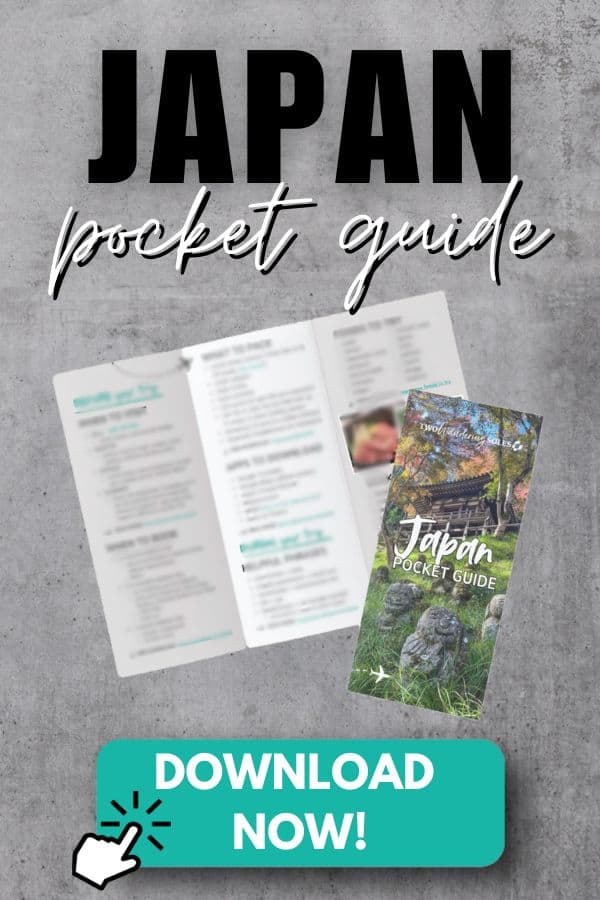Seeing Japan’s famous snow monkeys is a magical experience that tops many travelers’ bucket lists. This guide will tell you everything you need to know to plan the perfect visit to Jigokudani Monkey Park.
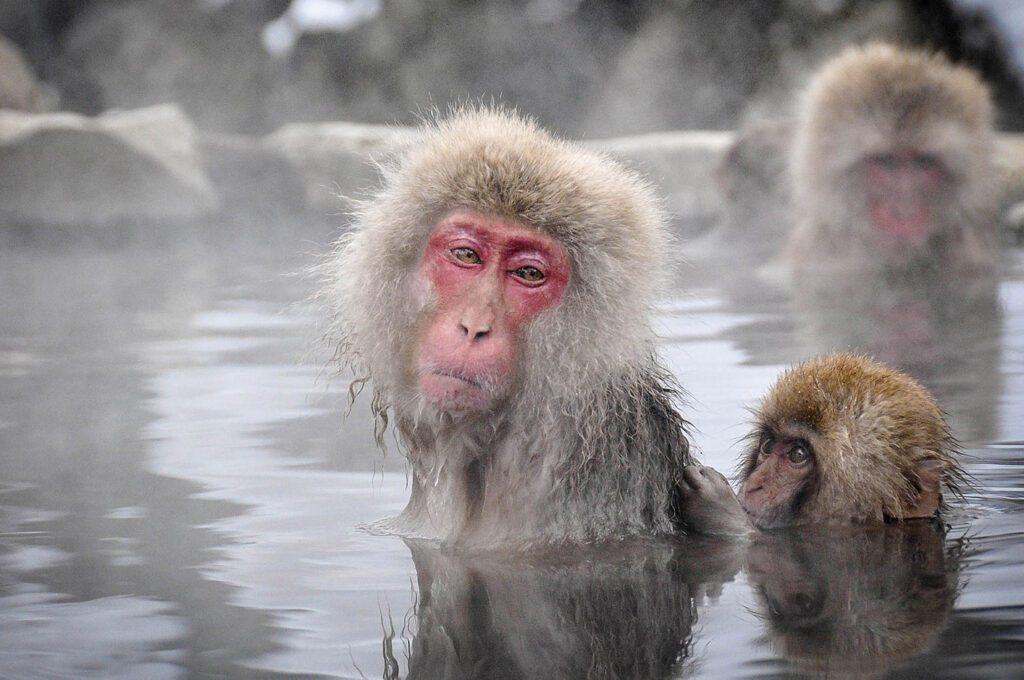
Nestled in a picturesque river valley, Jigokudani Yaen Koen (aka Snow Monkey Park) is known for Japanese macaques that congregate in hot pools during the cooler months of the year.
Though monkeys can be found throughout much of Japan, this geothermal valley just outside of Nagano City is the only place in the world where you can observe them soaking in the hot springs. Tourists flock to witness this unique behavior, which is truly a sight to behold.
Seeing the famous snow monkeys should definitely be on your list of things to do in Japan; however, there are some important things to know before you go. In this guide, we’re sharing all the essential info along with insider tips from our own experience.
Enough monkeying around, let’s get started!
Jigokudani Monkey Park Guide
- Quick info
- Our experience
- Fun facts
- History
- FAQs
- Tips for visiting
- How to get there
- Best time to visit
- What to pack
- Where to eat
- Where to stay
Jigokudani Quick Info
- Entrance fee: ¥800 ($5 USD) adult, ¥400 ($2.50 USD) ages 6-17, children under 6 are free
- Hours: 9 a.m. to 4 p.m. daily November to March, 8:30 a.m. to 5 p.m. daily April to October
- Location: Nagano Prefecture
- Parking lot | Closest bus stop
Our personal experience at Jigokudani Snow Monkey Park

We have now been to this iconic Japanese snow monkey park twice, on two very different trips:
Our first visit was in 2015 when it was just the two of us traveling Japan on a tight budget. We visited in early February, after a light dusting of snow, making the whole experience magical. Even though the journey took 3 hours each way from Tokyo via train, it was completely worth it to us.
Our second visit was in November of 2023 when we were traveling Japan in a rental car (highly recommend this, by the way!). We also had our daughter with us, who was just under 2 years old at the time. She loved seeing the monkeys up close and we think it’s one of the best experiences to add to your itinerary if you are traveling with kids in Japan.
While the scene wasn’t quite as stunning without the snow, the bursts of colorful leaves still clinging to the trees made for an only slightly less beautiful scene. Had we been at Jigokudani Snow Monkey park for Japan’s peak fall foliage, it would have been breathtaking.
Since we’ve visited this park twice and have had some very different experiences there, we wanted to create a guide with our tips and advice so you know what to expect.
Fun Facts about Jigokudani Snow Monkey Park
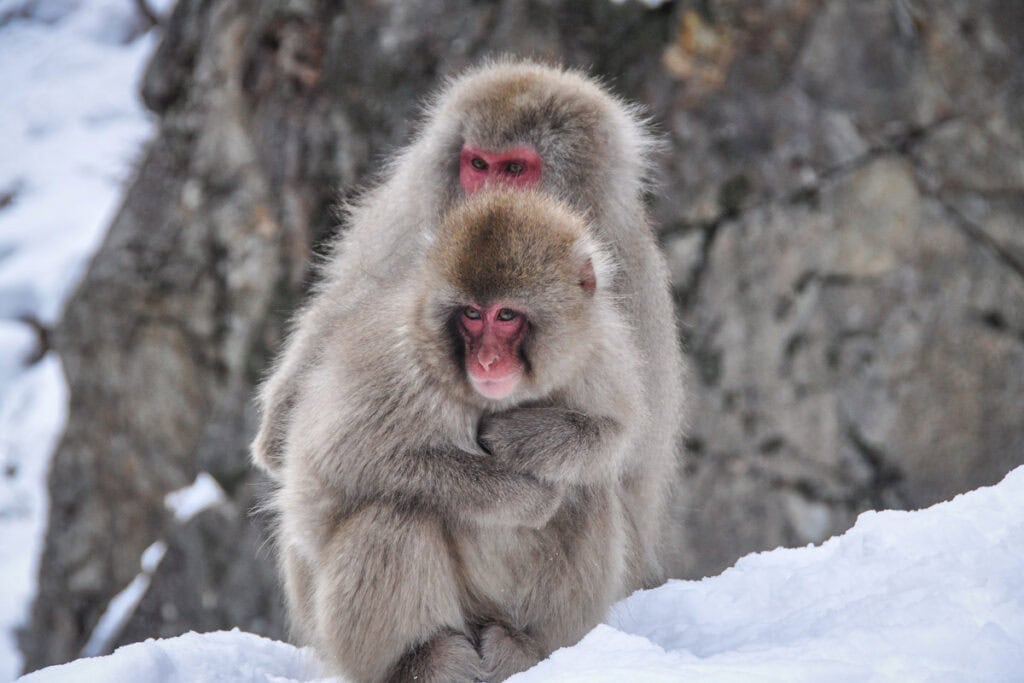
Let’s start with a few fun facts to get you acquainted with Jigokudani’s most popular residents:
- Jigokudani is home to more than 200 monkeys.
- The species found here are Japanese macaques. This species has the northernmost range of all non-human primates in the world.
- A group of Japanese macaques is called a troop.
- The average lifespan of Japanese macaques in the wild is 25-30 years.
- Females give birth every other year and will typically have around 10 babies in their lifetime. The gestation period is roughly 26 weeks.
- Jigokudani is nicknamed “Hell’s Valley” for its geothermal activity, its high, sheer cliffs, and its harsh winters.
- In addition to the famous monkeys, Jigokudani is home to a range of other wildlife, including Japanese serow, Asiatic black bear, and wild boar.
History of Jigokudani Snow Monkey Park

The park was established in 1964 as a conservation area where Japanese macaques could be observed in their natural habitat. As for what brought the monkeys to the valley in the first place, there are a couple of different theories…
Some say the monkeys saw humans bathing at a nearby onsen ryokan and copied the behavior. Then, in the interest of hygiene, the monkeys were given their own separate hot pool.
Another story goes that the development of ski resorts in the mountains drove the monkeys into the valley in search of food and they became a common pest around the local farms. According to this story, feeding began to keep them away from the farms, thus protecting both the crops from the monkeys and the monkeys from the farmers. Some say they first entered the hot pools to retrieve stray apples and found that they liked the warm water.
However it started, the behavior has been passed down for generations, becoming ingrained in the society of the Jigokudani troop.
In January 1970, the cover of Life magazine featured a photo of a Japanese macaque with snow-frosted hair taking a dip in the hot pool. The iconic image by photojournalist Co Rentmeester introduced the “snow monkeys” to the world, skyrocketing their rise to fame.
FAQs

You probably have lots of questions about visiting this famous Japanese landmark. Let’s get you some answers!
How difficult is the trail?
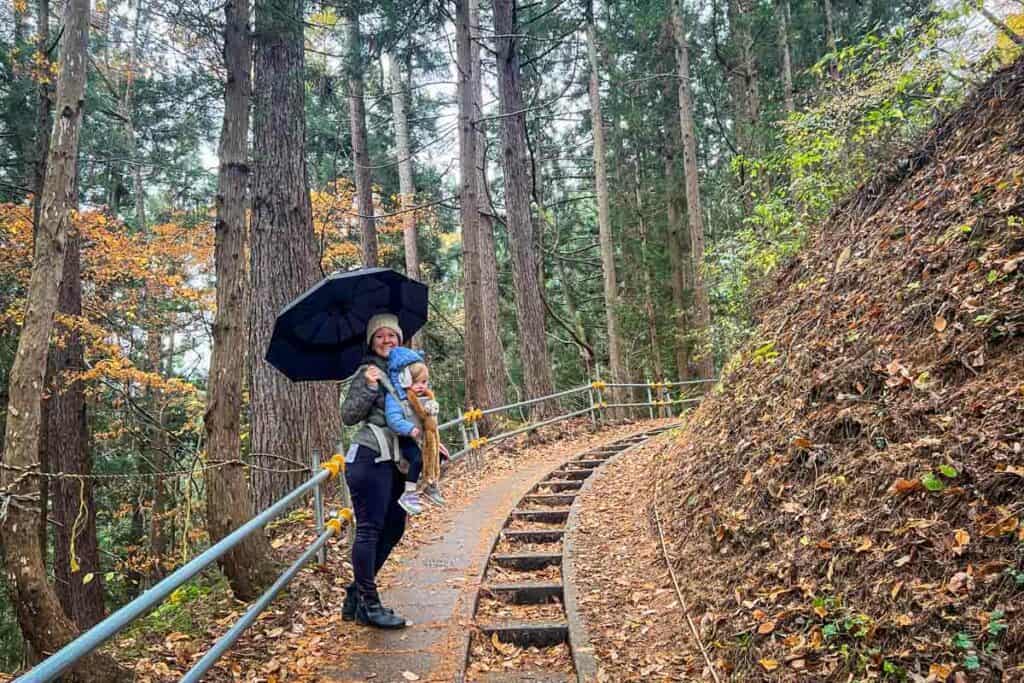
To get to the park from the parking lot, you’ll have to walk about 30 minutes through the forest on a gently sloping trail, following the Yokoyu River.
It’s an easy walk that people of varying ages and abilities can do; however, it is not wheelchair or stroller accessible. The path can also get muddy in the rain and slippery in the winter, so use caution and make sure you have appropriate footwear.


The incline becomes a little steeper toward the end. You’ll see an onsen resort on the other side of the river, climb some stairs, and come to a building where you will purchase your ticket. Know that once you go through the ticket building, there’s no re-entry.
After that, it’s a short walk down to the hot spring. Spend about 1-1.5 hours taking pictures of the monkeys soaking in the hot pool and playing with each other, and then hike back.
Trail stats:
- Distance: 5 km / 3.1 miles
- Elevation gain: 165 m / 541 ft
- Difficulty: easy
- Type of trail: out & back
- View trail notes
Are the monkeys wild?

Yes… and no.
The area is a natural habitat for Japanese macaques. The park itself is a protected wildlife reserve, but it’s large and still allows the monkeys to roam freely throughout the mountains and valley (similar to an African game reserve).
However, people have been feeding these monkeys for decades, intentionally attracting them to the hot spring. They’re used to being around humans and don’t see us as a threat. Most of the time they will ignore you, unless they think you have food.
So, even though they aren’t caged or domesticated, they aren’t exactly wild, either.
Is it crowded?
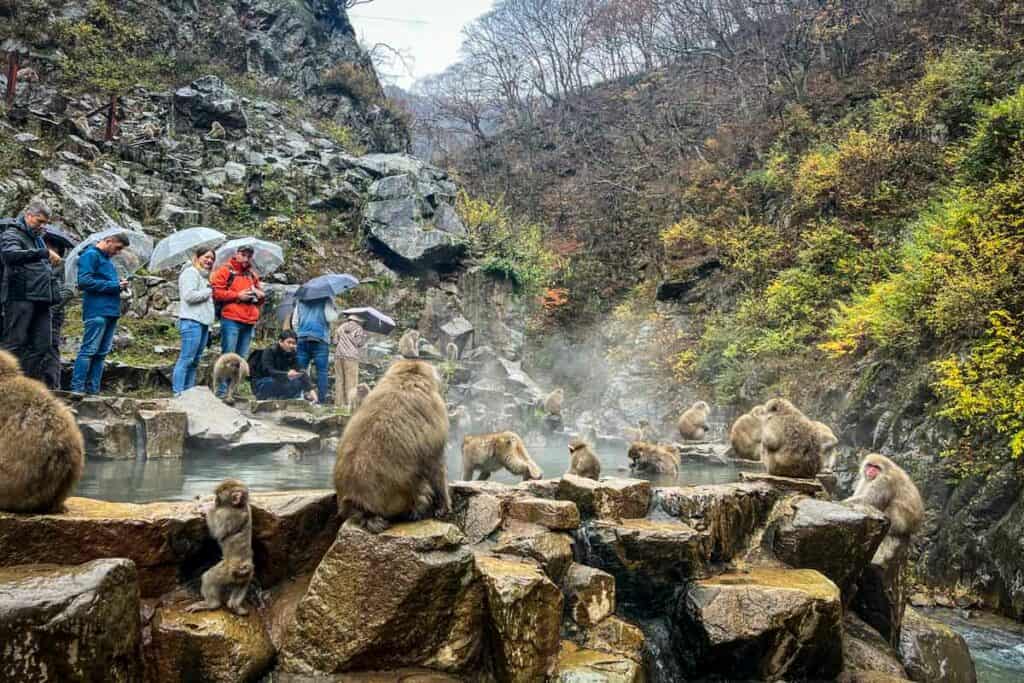
This is a popular attraction, and unless you’re the first ones there when they open (and even then), there will most certainly be others around. That said, in our experience, it wasn’t an overwhelmingly crowded place.
From our trip to Japan in 2019 to our most recent visit in 2023, we noticed some places have grown dramatically in popularity, thus crowds have grown.
We felt like the snow monkey park had just about the same level of crowds in 2023 as it had in 2015.
Is Jigokudani Monkey Park child friendly?
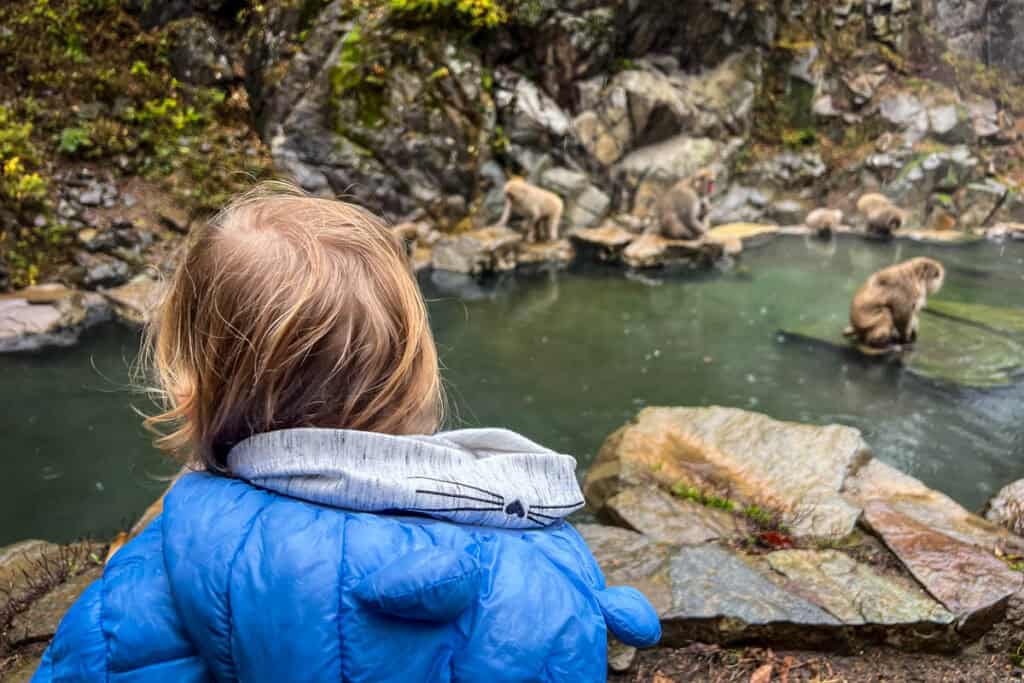
Absolutely!
On our second visit, we brought our daughter, who was 2 years old at the time of the trip. She loved watching the monkeys bathing in the hot spring, the mamas cuddling their babies, and the younger monkeys playing together.
If you’re visiting with children, here are a few things to keep in mind:
- It is very important that you keep an eye on your child at all times and don’t let them get too close to the monkeys.
- If you’re traveling with a baby or toddler, opt for a carrier instead of a stroller for this activity. (This is the carrier we personally brought and traveled all around Japan with.)
- There are no restrooms inside the park, so make sure you go before you head in. There’s a public restroom right beside the parking lot.
Personal anecdote:
We told Juni she could bring a stuffed toy to the park and she (unsurprisingly) chose a monkey. When we got there, the staff told us to keep the toy hidden in our bag because the monkeys might think it was real.
I don’t know if this happens often, or if it’s because the toy was a monkey specifically, but you can check with the park staff if you have any questions about what you can bring into the park. There are also lockers at the park entrance for anything you don’t want to carry with you.
What else is there to see at Jigokudani?
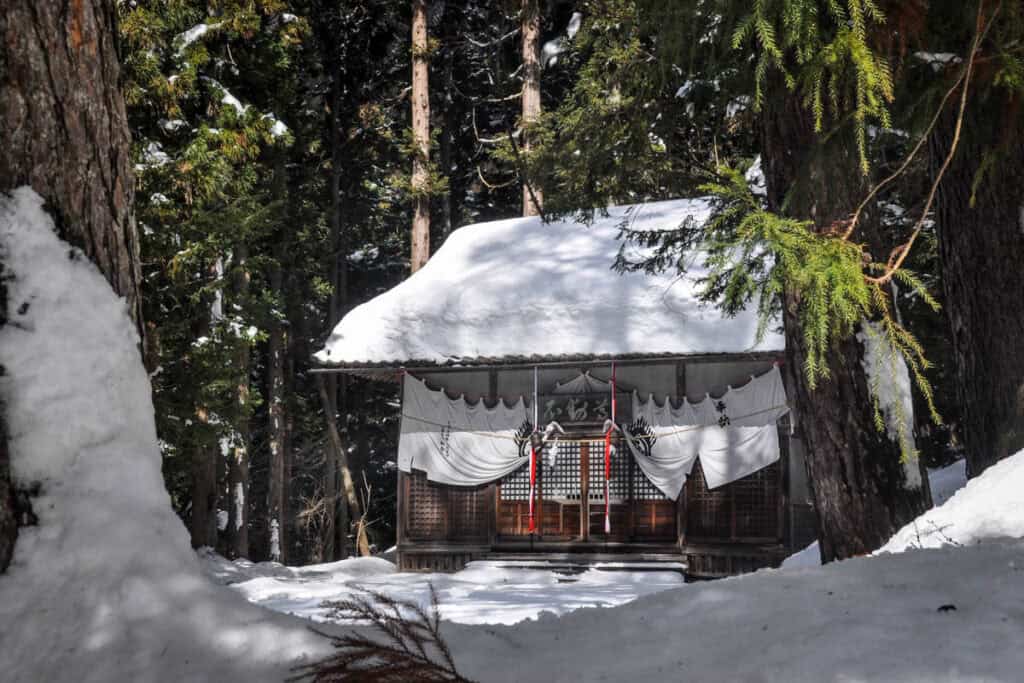
Not a whole lot, to be honest. There’s a small geyser near the park entrance called “Jigokudani Fountain”, a pretty temple, and the natural scenery. But really, you come here to see the monkeys.
Can I visit as a day trip from Tokyo?
While it is possible to visit Jigokudani as a day trip from Tokyo (this is what we did our first time), be warned: it makes for a very long day.
Whether you’re driving or taking public transportation, it takes about 3.5 hours to get to Jigokudani from Tokyo. You should give yourself 2-3 hours for the hike and watching the monkeys, and you’ll probably want to get a bite to eat at some point. Add it all up and you’re looking at a 10-12 hour day.
There are some really cool places to stay nearby and lots of fun things to do in the area, so it’s well worth it to spend a night or two if you have the time.
Tips for visiting Jigokudani Snow Monkey Park

Here are a couple of extra tips to help you prepare for your visit to Jigojudani Monkey Park.
Wear sturdy shoes
While not necessarily challenging, you’ll want shoes that are suitable for walking on a trail. After a rain, it can get muddy, so keep that in mind.
During the winter, the trail that leads to the monkey park gets very icy, so wear sturdy footwear with a good grip. I lost track of how many people I saw fall. (And I made the list once or twice!)
Never feed or touch the monkeys
This should go without saying, but I’mma say it anyway: you are here to observe the monkeys in their natural habitat, not to interact with them.
During our visit, we saw some young men baiting a monkey with a banana for a video they were recording. The park staff got really angry and the men were told to leave.
Not only is it against the rules, but the monkeys can get pretty aggressive with each other. We saw monkeys fighting both times we visited.
→ Psst! If you’re looking for a place in Japan where you can feed pseudo-wild animals, check out Nara Deer Park.
How to get there

It takes around the same amount of time to get to Jigokudani from Tokyo whether you take public transportation or self-drive, so the choice really comes down to your travel style.
By train
- From Tokyo Station, take the JR Hokuriku Shinkansen to Nagano Station.
- 1 hour 17 minutes
- ¥8,140 / $54 USD
- Hop on the Nagano Dentetsu Line Limited Express train to Yudanaka Station.
- 38 minutes
- ¥1,290 / $9 USD
- Take a local bus to the Snow Monkey Park bus stop.
- 15 minutes
- ¥310 / $2 USD
- Walk the wooded trail to Jigokudani.
- 30 minutes
By car
The fastest driving route from Tokyo to Jigokudani Monkey Park is about 3.5 hours. Follow these directions to the free parking lot at the trailhead, then walk the rest of the way to the park.
Note: You may need to alter these directions depending on where you’re staying in Tokyo.
Best season to visit

Winter is the best season to visit the park. They’re nicknamed “snow monkeys” for a reason!
When we first visited in early February, the towering pines lining the path to the park were frosted with snow, giving the whole valley a magical atmosphere. With the snow on the ground and a chill in the air, the monkeys were in full spa mode, soaking contentedly in the warm water.
It was pretty much exactly as we had pictured.
Our second choice after winter would be in autumn, during peak foliage. Unfortunately, when we visited in November 2023, most of the leaves had already fallen and the trees were pretty bare. Bummer.
On the flip side, the air was cool enough that the monkeys were happily bobbing in the hot pools, and we still had an amazing experience.
Fall is also mating season, so you may see some—ahem—monkey lovin’. During mating season, the macaques’ pink faces and rumps turn bright red, and males will be trying to impress the females. They may be more territorial and competitive than usual.
Good to know: If you’re visiting during seasons other than winter, it can be muddy and not quite as picturesque as the photos you see where everything is dusted in snow. Come with realistic expectations and we still think you’ll enjoy it.
The monkeys are far less active during the warmer months, opting to hang out in the shade of the forest instead of bathing in the onsen. (Having experienced the heat and humidity of summer in Japan ourselves, we can’t blame them!)
Spring might sound like an appealing time to visit, as the peak birthing season is from late April through June. However, we saw plenty of babies on both our February and November visits, so we wouldn’t base our decision on that.
Best time of day to visit
Our recommendation would be to start your day as early as possible so you can get to the park for when it opens or shortly after. Not only does it get busier and more crowded later in the day, but the monkeys are more active in the morning and some of them start to head back into the mountains by the afternoon.
What to bring (and what NOT to bring)
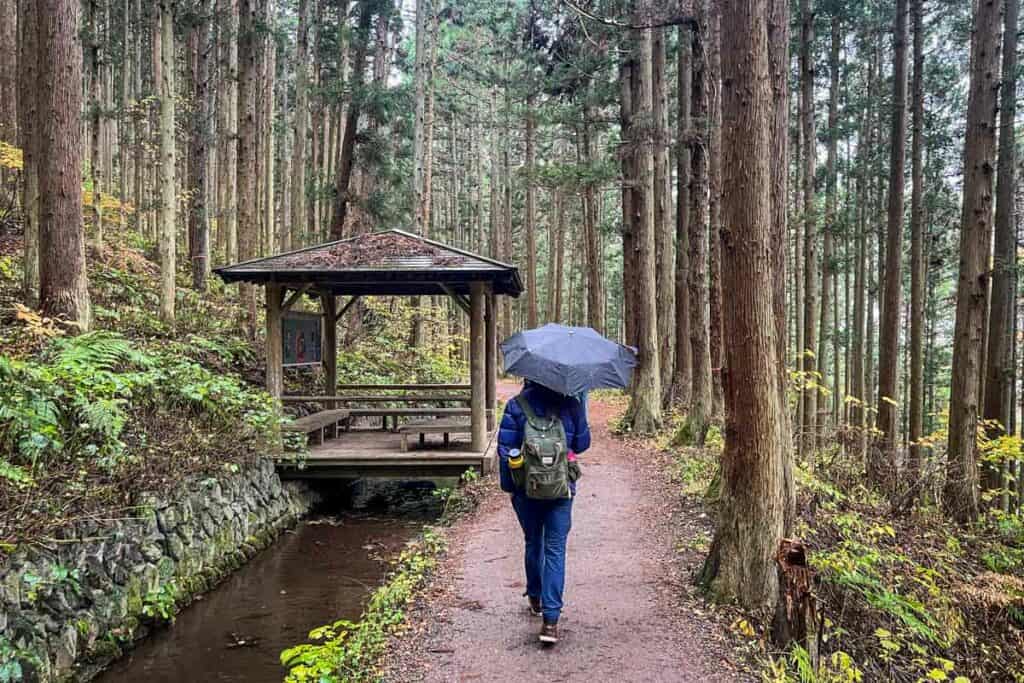
There are a few important rules about what you can and can’t have with you in the park. We’ll let you know which items to keep secured in your bag, which items to leave at your hotel, and a few things you definitely won’t want to forget.
Do NOT bring:
- Plastic bags: Monkeys may steal them thinking there’s food inside, then they become litter. Keep plastic bags hidden away; or, better yet, opt for reusable bags instead
- Food: Keep food hidden and secure. Do not eat or have food out while in the park.
- Selfie sticks & drones are not allowed in the park
- Sunglasses: Make sure they are stored securely in your bag and out of sight, as monkeys have been known to steal sunnies
- Pets: No pets are allowed, including service animals
DO bring:
- Comfortable footwear: You’ll be walking a forested path for about 30 minutes each way. The trail can get super muddy in the rain and slippery in the winter, so choose sturdy shoes with good grip.
- Camera
- Portable charger (this is our favorite power bank we’ve had for years!)
Be sure to check out these super helpful guides full of packing hacks and tips for traveling in Japan that you won’t find anywhere else:
- Our Japan packing guide lists all the essentials (many of which you might not think about), as well as what you should NOT pack for a trip to Japan.
- This article on what to wear in Japan will help you create a perfect capsule wardrobe for every season and let you in on some cultural taboos so you can be sure to dress appropriately.
- With this FREE Japan packing list PDF download, we’ll send checklists straight to your inbox for everything from clothing and toiletries (for both women and men!) to what shoes to pack and extra stuff you may want to have on-hand just in case. Click the image below to get your free copy!
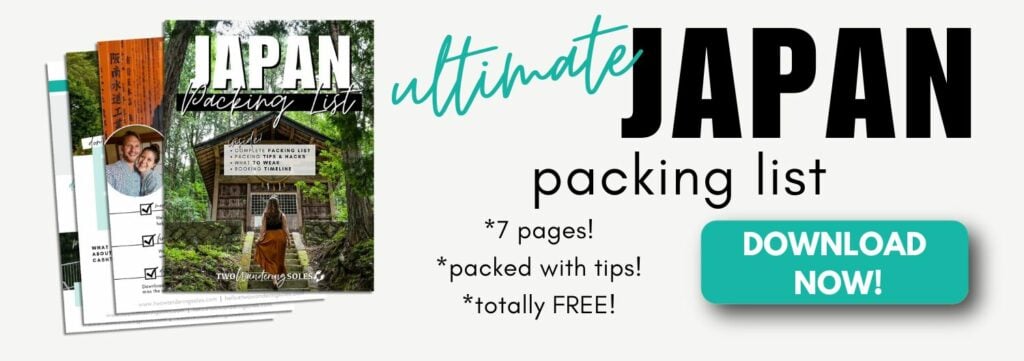
Where to eat (& drink) nearby
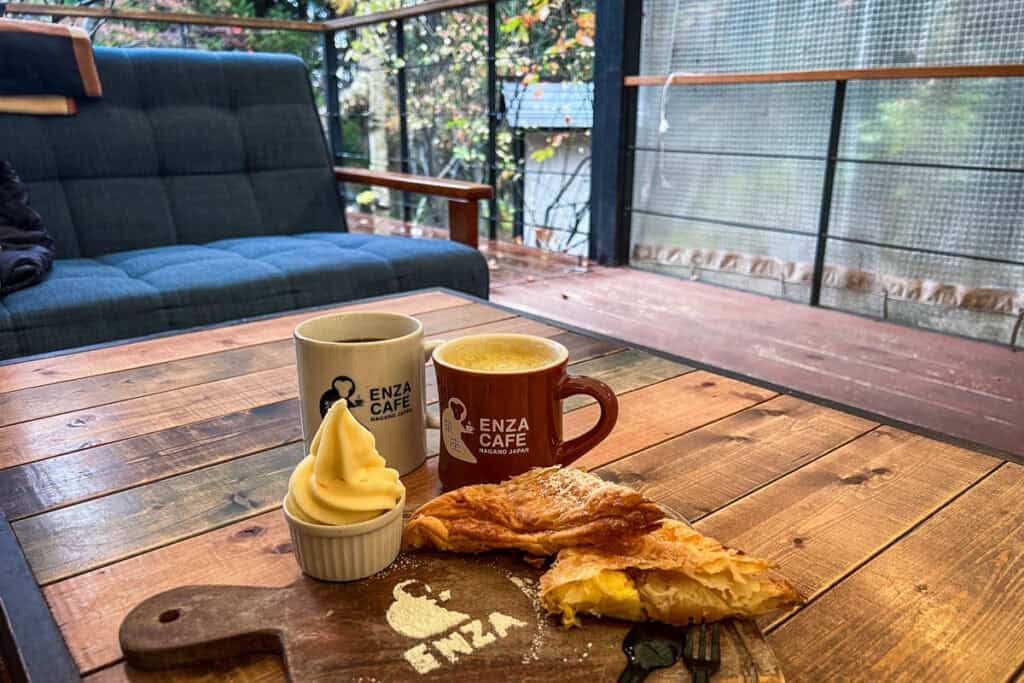
If you’re feeling peckish after your visit to the park, there are a couple of places nearby to grab a bite.
- Enza Cafe: We personally ate at this cafe right next to the Jigokudani parking lot. Their specialty is apple pie—which is more like an apple turnover—with ice cream (this region is known for apples). Because we were hungry, we also got ramen, which was really satisfying on a chilly fall day.
- Insider tip: Grab a table on the terrace if it’s nice out!
- The Farmhouse: Cozy spot with comfort food and beer
- Tamamura Honten: This sake brewery also sells local beer, which is interesting to try. They don’t do tastings in the shop, but they can describe the sake to help you choose what to purchase. There’s also a little museum of sorts with some very basic “exhibits” on sake-making.
Where to stay nearby
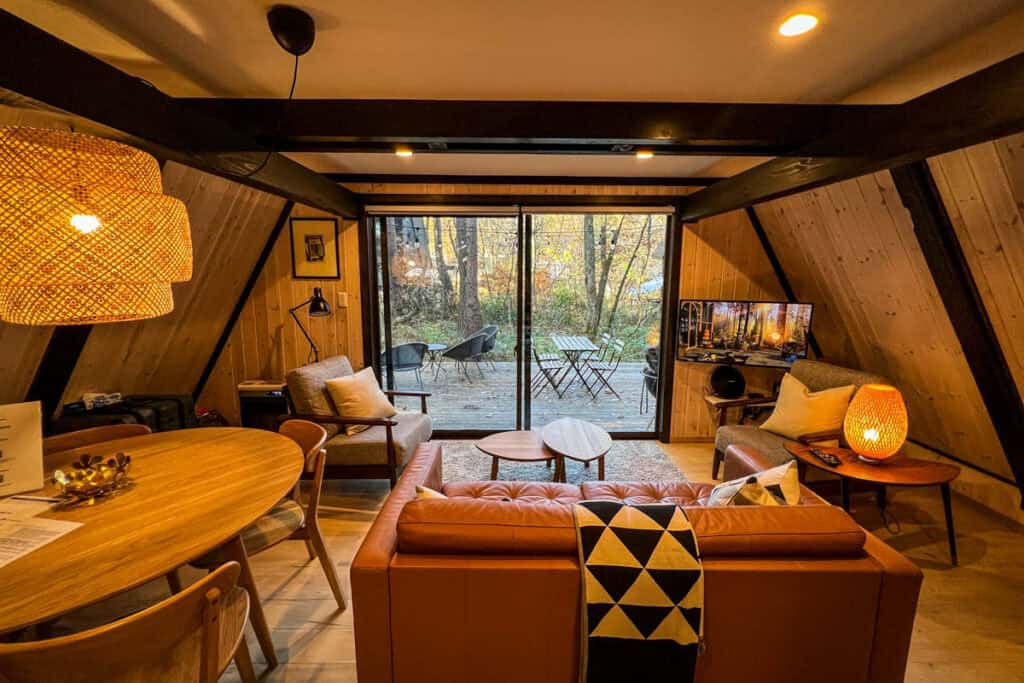
You have several options for where to stay near Jigokudani Snow Monkey Park. You could visit as a (very long!) day trip from Tokyo, or you could stay right beside the park in the village of Yudanaka. Alternatively, you could base yourself elsewhere in Nagano prefecture, like in Hakuba or Nagano City, so you can explore more of what this region has to offer.
Yudanaka
- Small onsen town
- 30-minute walk or a short drive
This small village is located at the edge of Jigokudani Valley and is the closest place you can stay to the snow monkey park.
- Minshuku Miyama: guests rave about the food at this ryokan, which boasts a gorgeous private open-air onsen
- Koishiya Ryokan: located in the historic Shibu Onsen district, guests at Koishiya Ryokan have access to 9 public baths
Hakuba

- Ski resort town
- 1 hour 20 minutes by car
Personally, we based ourselves in Hakuba while exploring Nagano prefecture. (We loved this cute A-frame cabin in the woods!)
From Hakuba, the snow monkey park is just a 1 hour 20 minute drive away, so it was a great day trip. On the way back to our cabin, we stopped in Nagano city to explore a bit more!
Nagano City

- Largest city in Nagano prefecture
- 50-minute drive
Another option is to base yourself in Nagano City. Staying in the city will give you more accommodations to choose from, including some budget-friendly options.
- Budget stay: Hotel Metropolitan Nagano
- Conveniently located at Nagano Station, the rooms at this hotel resemble chains like Quality Inn and start at just $64 per night.
- Mid-range stay: Dormy Inn Nagano
- Only a minute’s walk from Nagano Station, this hotel has indoor and outdoor baths as well as a sauna.
- Great for families: Kominkahu kashikiri cottage Tokei
- This 2-bedroom vacation home sleeps up to 6 guests and features a large patio and a koi pond.
Plan your trip to Japan
After 3 trips (and counting!), we’ve fallen head over heels for Japan—and we’ve created TONS of resources to help you plan your dream trip. Start with our Ultimate Japan Travel Guide and be sure to check out these helpful articles:
- First time? Our Japan Trip Planner walks you through everything you need to know.
- Use our Japan Rail Pass guide to determine if getting a train pass is optimal for your trip.
- Here’s our curated list of the best things to do in Japan—from iconic sights to once-in-a-lifetime experiences.
- Not sure where to go? Our Japan itinerary ideas will help you map it all out.
- Foodies, rejoice! This guide to what to eat in Japan will have you drooling before you land.
- This guide to what to wear in Japan (and what not to wear) will help you blend in.
- Use our ultimate Japan Packing List to make sure you don’t forget anything.
- Before you go, brush up on these essential Japan travel tips (including major do’s and don’ts!).
- Avoid awkward moments by brushing up on Japanese etiquette.
Still have questions? Drop us a comment—we LOVE helping travelers plan unforgettable trips to Japan!
Perfect Japan itinerary
Want the perfect itinerary planned for you?

If you don’t have a ton of time to spend planning your Japan itinerary (or you just don’t find travel planning fun), we’ve got something you might be interested in…
We created the ultimate done-for-you Japan itinerary that is packed full of all sorts of tips we’ve gathered from 3 trips to Japan as well as literally hundreds of hours of research (no exaggeration).
We have both an off-the-beaten path route as well as a classic itinerary that hits the top attractions (perfect for your first visit to Japan!).
Don’t miss your chance to grab our Japan Pocket Guide!
This (totally FREE!) pocket guide is a condensed version of all the things you should know BEFORE & DURING your trip to Japan!
Just enter your email and we’ll immediately send our pocket guide straight to your inbox!
Save this article on Pinterest for later!


We want to hear from you!
Have you been to Jigokudani Monkey Park before? Do you still have questions about visiting Japan’s snow monkeys after reading this article? Let us know in the comments below and we’ll do our best to get back to you!

